Getting started with a new exercise routine can seem daunting and expensive especially when you’re on a budget. There are a lot of pressures to spend your hard-earned money on exercise gear, equipment, memberships and trainers or coaches. But you don’t need a big budget to get active, improve your fitness and reduce your health risks.
Throughout history people have coped quite well with little or no special exercise equipment. So what IS the best way to improve strength, flexibility, endurance and cardio health when you’re on a budget? In this article I share with you how you can make walking your go-to exercise of choice and how you can vary your walking routine so that you stay motivated and keep your fitness progressing along ….. all on a budget!

Money, money money!
Australians spend billions of dollars a year on exercise – memberships of gyms and clubs, exercise classes, clothing, equipment, massages, personal trainers and more. Can you believe that about a third of the population pay for gym memberships but almost half of these people only occasionally use the gym, maybe 1-2 times a week? That’s a huge investment for minimal health gains!
Gym memberships are only one way to get your exercise in. There are many other ways you can spend your exercise budget – sports clubs, specialised gear and clothing, race entries, travel and accommodation to participate in races, training programs, and renovations and equipment to make your own home gym.
If you’re just starting out and want to get an exercise program going, this can seem daunting and expensive. Maybe you won’t like that sport, or maybe you won’t enjoy the gym environment. What if you purchase all the gear and equipment and then decide it’s not really for you?
Don’t fall into the trap of spending big in order to exercise. You have other options if you don’t want to spend a lot of money, or if you don’t want to spend any money at all. There are plenty of pressures out there to hand over your hard-earned money on everything in life including exercise. It’s easy to get hooked into marketing campaigns and the latest health fad which often leads people into comparisonitis, FOMO (fear of missing out) and an unhealthy focus on changing your body’s appearance. You can easily get sucked into believing that you HAVE to spend up big to get fit and healthy.
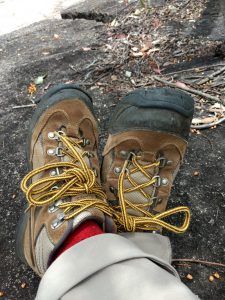
Get back to the basics with exercise
I love going to the gym and I find some of the modern technical clothing very comfortable. These things can certainly enhance your enjoyment of exercise but throughout history people have coped quite well with little or no special exercise equipment. Remember, the aim of exercise is to improve strength, flexibility, endurance and cardio health by putting a load on your body. And that doesn’t have to cost anything!
Generations before us didn’t need all the gear and memberships! Exercise was part and parcel of a hard day’s work fixing fences, chopping fire wood, baking bread by hand, walking or riding to the shops, and doing the laundry with a boiler and wringer!
Functional activity like this can provide you with plenty of exercise but today’s housework generally doesn’t cut it in terms of exercise. If you’re going to increase your physical activity without overspending, you’ll need to get back to the basics and make the most of opportunities all around you.
Start with a good pair of shoes
In my opinion, the most important piece of equipment you’ll need is a good pair of sports shoes. If you don’t have any, get yourself properly fitted out so that you protect your feet and minimise any injuries from poorly fitting shoes. Once you’ve got your shoes sorted, the rest is pretty easy. Pull on some comfy clothes, slop on some sunscreen, grab a hat and a bottle of water and you’ve got all the makings of one of the most accessible forms of exercise we have on the planet today – walking!
Walking is ideal exercise for most people wanting to improve general health and fitness. But if you have any concerns or medical issues, make sure you check with your doctor or health practitioner before beginning.
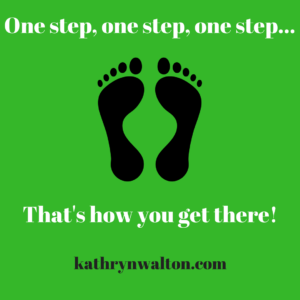
Walking is your ideal exercise on a budget
Walking is an ideal form of exercise because …..
- You can set your own pace
- There’s less opportunity for comparisonitis when you’re walking outdoors than when you’re in a group class or gym hall
- Walking is convenient – you can walk almost anywhere no matter where you live or work or travel
- You can walk alone or in a group
- You’ve probably already got everything you need to go walking
- If you don’t have everything, you still don’t HAVE to spend a lot to get started
- You don’t need any special equipment
- Walking is low impact exercise – perfect if you’re just starting out, coming back after injury or have joint pain.
- Walking is free (please note that there are day entry fees or car parking fees to some National Parks and recreation reserves)
- Walking is not boring if you change your routine regularly. Find a new place, pace, direction, gradient or length of walk. Ask someone to be your walking buddy or go alone. Walk at different times of the day including at night and explore different areas in different seasons. Adopt a different theme for each day to make it interesting – look for animals, clouds, sounds, colours on your walks.
- Educate yourself while you walk by listening to podcasts and audio books
- Listen to music as you walk and keep the pace
- Walking keeps you grounded. The process of making forward motion with each repeated step can get your mind and body in sync with the world around you.
- Spending time in natural environments can be settling when you feel anxious, down or stressed. Combine this with physical activity and you’re onto a winner!
- Meet up with others to stay motivated. Join a walking group or try your hand at Park Run.
- Vary your walks by including different elements and scenery. What urban walks interest you? Seek out as many flights of stairs as possible. Try a bush walk, wetlands walk or beach walk. Go barefoot at the beach and feel the sand between your toes. Pace out your steps around the farm paddock or check out your local park.
- Walk with a purpose – walk to work, school, a friend’s place, bus or train station, shops
- Have a go at orienteering using a map and compass
- Use a navigation app or GPS device to pre-plan your walk or record statistics of your walk for your own purposes or to share with others.
- Wearable devices with pedometers, smart phone apps and other data trackers can help with motivation to reach your goal (eg number of minutes walked, numbers of steps each day)
- Wear a backpack for added weight training whilst walking
- Schedule ‘walking meetings’ and ‘walking catch-ups’ into your week
- Go for a lunch time walk or an end-of-day walk to wind down and de-stress
- Earn as you walk – deliver newspapers or pamphlets along your way
- Go ‘window shopping’ – meander along a street with retail stores after business hours and enjoy your time to look around a part of town that you usually rush through
- Take your kids for a walk after school while everyone chats about their day
- Add value to your daily walk by incorporating a session at the local outdoor gym, a sprint along your favourite section, carry some hand weights along the way, or pause for a few yoga stretches midway.
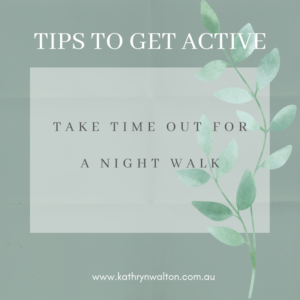
Make walking your ‘go-to’ exercise
Walking is my go-to exercise. I can go walking almost anywhere, any time that fits my schedule, and with minimal gear. You can spend heaps of money on exercise, but for most of us, we don’t have to. Walking is a fantastic opportunity to move your body and improve your health, fitness and your mental health. Did you know that walking is in fact the most popular form of exercise in Australia? Don’t miss out on the everyday opportunities to be kind to your mind and body! Begin your walking adventures with any of the ideas above and let me know how you go.
Do you have some other ideas about how to exercise on a budget? I’d love to hear from you!
Discovering mountain biking as life’s ultimate parallel universe in her middle age, Kathryn Walton shares information and reflections in ‘Daisy Spoke’ that inform, inspire and empower women to a healthy and active lifestyle.




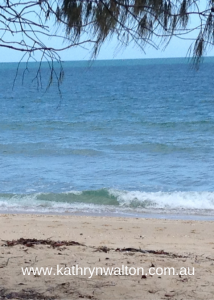

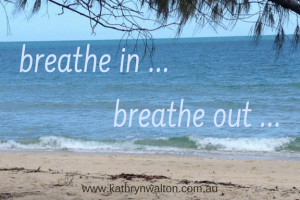
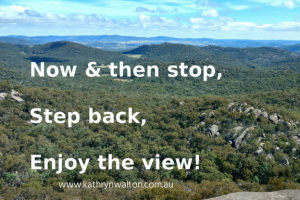
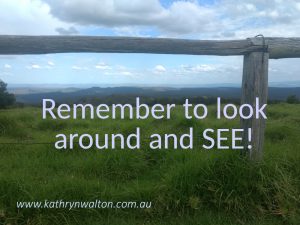
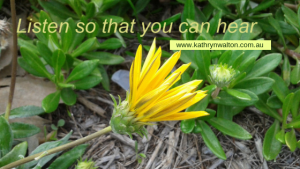

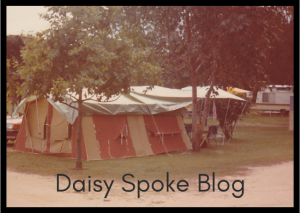
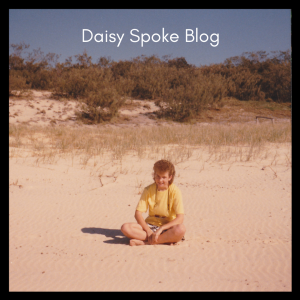
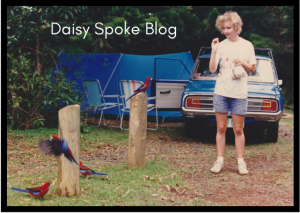
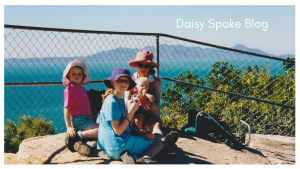
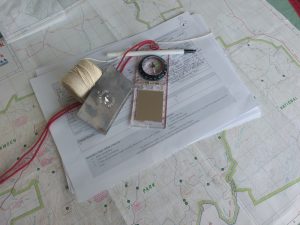

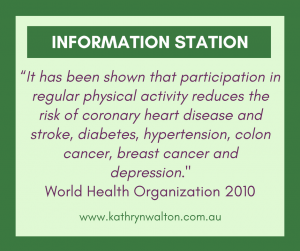
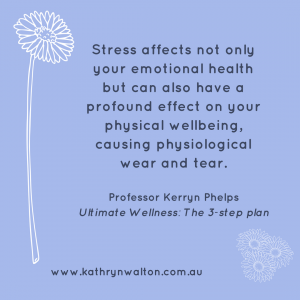

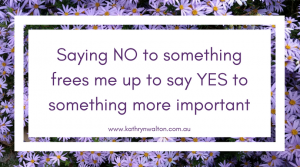

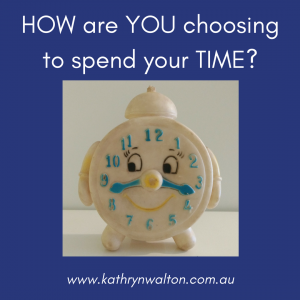
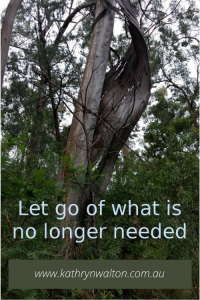
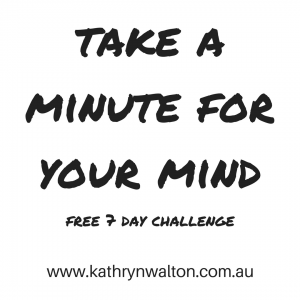
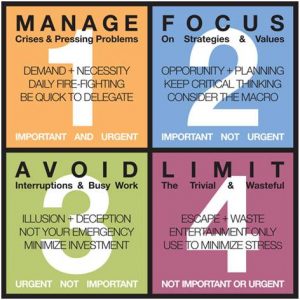
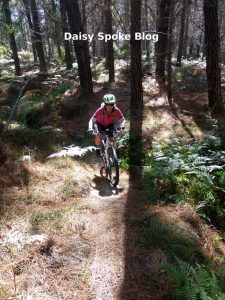 was missing it.
was missing it. 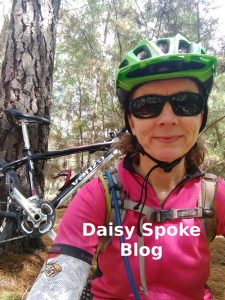 I’ve been practising and teaching this technique for a lot of years, and yet still I sometimes forget to do it when the moment arises. The thing is that on Sunday morning I DID NOTICE those fearful thoughts bouncing round my head. And guess what?
I’ve been practising and teaching this technique for a lot of years, and yet still I sometimes forget to do it when the moment arises. The thing is that on Sunday morning I DID NOTICE those fearful thoughts bouncing round my head. And guess what? 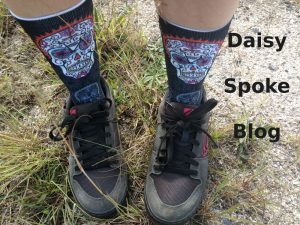 of short hills engaging my quads in an exertion that a couple of years ago would have been painful (if not impossible)! I pedalled in a higher gear than normal and found it easier than expected.
of short hills engaging my quads in an exertion that a couple of years ago would have been painful (if not impossible)! I pedalled in a higher gear than normal and found it easier than expected. 
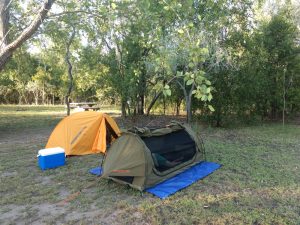 before we even set up camp we had a short walk around the area. A sudden loud rustle in the bushes next to us startled me. Turning around and expecting to see a wallaby, my daughter tells me I wouldn’t want to know what made that noise. On further enquiry she tells me it was a rather large snake, and I began to seriously wonder about moving our campsite further away from said snake.
before we even set up camp we had a short walk around the area. A sudden loud rustle in the bushes next to us startled me. Turning around and expecting to see a wallaby, my daughter tells me I wouldn’t want to know what made that noise. On further enquiry she tells me it was a rather large snake, and I began to seriously wonder about moving our campsite further away from said snake.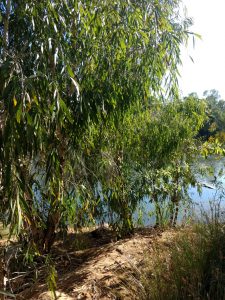 My uneasiness only increased as the evening rolled on and in particular when we came face to face with another snake only a few metres from our tents. Still, I wandered why the uneasiness was there in the first place. Was I sensing a spiritual presence? Was it simply that everything seemed strange and unfamiliar? Or perhaps the absence of other humans? Was I simply tired and misreading my intuition? Was it FEAR welling up and testing my inner strength?
My uneasiness only increased as the evening rolled on and in particular when we came face to face with another snake only a few metres from our tents. Still, I wandered why the uneasiness was there in the first place. Was I sensing a spiritual presence? Was it simply that everything seemed strange and unfamiliar? Or perhaps the absence of other humans? Was I simply tired and misreading my intuition? Was it FEAR welling up and testing my inner strength?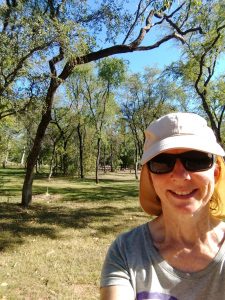 And so I survived. In fact I thrived and had possibly the best sleep so far on my April Adventure. I awoke before dawn, spent a couple of hours silently meditating, embracing my surroundings and feeling entirely captivated by what seemed so haunting and difficult the day before. I feel an immense sense of satisfaction that I didn’t allow my anxiety to rule and limit me. I chose to respect it but also to stand up to it. In doing so I’ve come to know an amazing spiritual aspect of this sacred land which I may not ever understand, but I can accept it and embrace it. And when I do that, I also accept and embrace myself.
And so I survived. In fact I thrived and had possibly the best sleep so far on my April Adventure. I awoke before dawn, spent a couple of hours silently meditating, embracing my surroundings and feeling entirely captivated by what seemed so haunting and difficult the day before. I feel an immense sense of satisfaction that I didn’t allow my anxiety to rule and limit me. I chose to respect it but also to stand up to it. In doing so I’ve come to know an amazing spiritual aspect of this sacred land which I may not ever understand, but I can accept it and embrace it. And when I do that, I also accept and embrace myself.